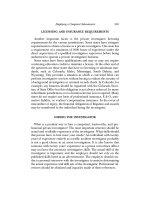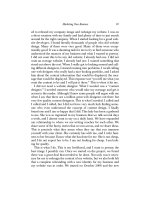Fund your dreams like a creative genius a guide for artists, entrepreneurs, inventors, and kindred spirits
Bạn đang xem bản rút gọn của tài liệu. Xem và tải ngay bản đầy đủ của tài liệu tại đây (987.46 KB, 114 trang )
Copyright © 2018 by Brainard Carey
All rights reserved. Copyright under Berne Copyright Convention, Universal Copyright Convention, and Pan American
Copyright Convention. No part of this book may be reproduced, stored in a retrieval system, or transmitted in any form, or by
any means, electronic, mechanical, photocopying, recording or otherwise, without the express written consent of the
publisher, except in the case of brief excerpts in critical reviews or articles. All inquiries should be addressed to Allworth
Press, 307 West 36th Street, 11th Floor, New York, NY 10018.
Allworth Press books may be purchased in bulk at special discounts for sales promotion, corporate gifts, fund-raising, or
educational purposes. Special editions can also be created to specifications. For details, contact the Special Sales
Department, Allworth Press, 307 West 36th Street, 11th Floor, New York, NY 10018 or
22 21 20 19 18 5 4 3 2 1
Published by Allworth Press, an imprint of Skyhorse Publishing, Inc., 307 West 36th Street, 11th Floor, New York, NY 10018.
Allworth Press ® is a registered trademark of Skyhorse Publishing, Inc.®, a Delaware corporation.
www.allworth.com
Cover design by Mary Ann Smith
Illustrations by Brainard, Delia, and Shiva Carey
Library of Congress Cataloging-in-Publication Data is available on file.
Paperback ISBN: 978-1-62153-648-2
eBook ISBN: 978-1-62153-650-5
Printed in the United States of America
This book is dedicated to Delia and Shiva.
CONTENTS
Introduction
Chapter
Chapter
Chapter
Chapter
Chapter
Chapter
Chapter
Chapter
Chapter
Chapter
Chapter
1 | Create a Product
2 | Auctions for Everyone
3 | A Moveable Feast: Fundraising over Dinner
4 | Texting Your Way to Full Coffers
5 | Fundraise by Design
6 | Start a Festival
7 | Write Letters the Old Way
8 | P2P Campaigns: Viral Gold
9 | Angels and Venture Capitalists
10 | Pet Parties: Local Fundraiser for Any Cause
11 | The Classics, Abbreviated and Ready for Updating
Afterword
Suggested Reading
Index
INTRODUCTION
If you only use one good idea from this book, the cost of buying it will be
repaid many times over.
Want more cash? Read this intro quickly—
This is a book for anyone who has an ounce of creativity in them—you could be an
entrepreneur, an artist, a teacher, or anyone at all who is willing to go outside of traditional
routes (a job) to gain income or a one-shot infusion of cash. You can use the money for a
dream you have or a cause you want to support or an artistic or activist project you want to
see realized. There are no limits or parameters on how the money is spent.
Sponsors, Patrons, Donors, Customers, and Angels are simply relationships, as well as
parts of techniques you can use to have your event or visionary work sponsored by
businesses and corporations to keep your dream alive and growing.
Sound dreamy? It’s how almost every museum, filmmaker, and every individual dreamer
raises millions a year, and it can easily work for you if you know the process.
So, if you want to know more in a short time, take this slim volume home and read it and
then activate one of the possibilities I present. Read them all to see which one sounds like
the most fun and easiest for you to do. Some of these ideas may seem impossible for you
to do. Every idea will take effort for you to realize. Yet if you only use one good idea from
this book, the cost of buying it will be repaid many times over.
How much are we talking about here? Anywhere from $500 to hundreds of thousands. In
most cases, after raising money successfully once, you will find it easy to repeat the
process, which is often a bit addictive because getting what you need and want is a turn-on
for most people. An active person fundraising tends to raise more and more every year,
because it gets easier once you understand the system.
Also, if you complete reading this short book, you can write and ask the author (me)
questions, as well as send in your success stories. I plan to use the time you give me
wisely so you can profit sooner rather than later with this book. Questions can be sent to
An active person fundraising tends to raise more and more every year,
because it gets easier once you understand the system.
“If you are distressed by anything external, the pain is not due to the thing itself, but
to your estimate of it; and this you have the power to revoke at any moment.”
—Marcus Aurelius, Meditations
Chapter 1
CREATE A PRODUCT
Money. It’s what makes a business or most dreams flourish and is also what stands in the
way of growth. In the early stages of every new venture, the very first concern and top
priority is always where the money will come from. It used to be that in order to start a
business the route was to visit the bank, provide reasonable collateral, and secure a loan.
These days, with an economy that is often highly volatile and with the advent of the internet
constantly changing the landscape of how things are done, the era of the bank loan is
rapidly fading. Crowdfunding has taken the place of traditional overhead capital in many
cases through sites like Kickstarter and Indiegogo. But what if you want to circumvent even
these modern traditions and find a way to raise capital even more independently? What if
you would prefer not to give a percentage of all income raised to one of the many online
platforms like Indiegogo, Patreon, and Kickstarter?
The fact of the matter is, there are countless ways to secure yourself a little extra green on
the side; the only obstacle is the limit of your imagination. Just ask Brian Chesky, CEO and
founder of the now ubiquitous vacation and short-term rental platform Airbnb. In the early
days of this business, Chesky and his cofounders Nathan Blecharczyk and Joe Gebbia had
a problem. They were rapidly running out of money to run their nascent, unknown start-up.
The business itself was the result of chance. When a design conference flooded into San
Francisco creating a space issue—there simply weren’t enough hotel beds to fit every
participant—the three cofounders used the lack of space to their advantage. Low on funds
and needing to pay the rent, they opened their loft space to conference participants. Three
air mattresses plus complimentary breakfast at $80 a pop not only helped three visitors find
a place to stay, it got the rent paid and gave rise to what would become Airbnb.
There are countless ways to secure yourself a little extra green on the side;
the only obstacle is the limit of your imagination.
Fast-forward to Denver, Colorado, in 2008. The Democratic National Convention was
presenting the very same temporary housing need as the San Francisco design conference,
and Airbnb was still in its very early stages. The team needed to solve a fundamental
problem, which was figuring out how to fund their business enough to market it and bring in
more paying customers.
They already knew that the DNC was a tremendous opportunity. The idea of people
opening their homes to others was catching on. But things weren’t growing quite fast
enough; they needed another way to keep their little boat afloat.
That’s when they came up with a most unconventional idea in order to capitalize on the
convention in town. They would sell cereal.
You read that correctly.
They would sell cereal. The team ordered a thousand boxes from a local printer, got
themselves a glue gun and some cereal, and went to work. They created a limited-edition
series of politically themed cereals, namely Obama O’s and Captain McCain. Each variety
had five hundred boxes each, individually numbered and filled with real cereal. In the lead-up
to the Democratic National Convention, the team sold off their cereal boxes for $40 each. It
was thinking so far outside the . . . well . . . box, they had no idea whether their plan would
pay off.
It took a bit of hustling to get the word out about their limited-edition breakfast series. The
team turned to small-time bloggers asking them to run features to small audiences. This
grassroots marketing began to snowball and eventually landed them on national network
news, giving them and their cereal start-up funding an enormous boost.
Against all odds, the Airbnb founders sold every last box, raising $40,000 that would allow
them to dig out of the serious debt running their little business had put them in. They took
their capital and their unusual idea to Paul Graham, asking him for a spot in his start-up
accelerator Y Combinator.
Graham was skeptical at first—this was 2008 and the markets had just crashed, setting off
what would become the recession. He was looking for businesses that could survive during
the austere times ahead. He was unconvinced that a rental company was one of those
businesses.
Just when it looked like Airbnb would have to seek elsewhere, they revealed their unusual
method of raising capital. Graham was so impressed by the success of the cereal boxes,
he offered the team a spot. Their absolute ingenuity proved to the entrepreneur that they
had what it takes to keep a business going even when success is slow and debt is piling up.
When it comes to funding your business, your art, or whatever your dream is, the sky’s the
limit as far as ideas go. If you are an artist, you have a serious advantage in that you are
already used to thinking in ways that are completely different to the traditional ways the
world goes round. Make this perspective work for you. Create and imagine ways you can
earn money to keep your business or art practice afloat. Learn from the example of the
Airbnb crew that sometimes, when the moment is right, the most outlandish ideas are the
ones that will get you the furthest.
If you liked that idea, keep reading until you find the approach that seems the most exciting
and most comfortable to you.
Against all odds, the Airbnb founders sold every last custom cereal box,
raising $40,000 that would allow them to dig out of the serious debt running
their little business had put them in.
CHAPTER 1 CHECKLIST
1.
Write down the goal amount to be raised.
2.
Come up with a product that is easily made and also attractive.
3.
Give yourself a specific time frame to reach your financial goal.
4.
Make your product (or have it fabricated).
5.
Find a place that is heavily trafficked to sell your product.
6.
Use social media to promote your product or event.
7.
Reach out to bloggers for more coverage.
8.
Write a press release about what you are doing.
9.
Make a schedule on your calendar to manage your time on these tasks.
10.
Follow up with any media inquiries; have a press kit ready.
11.
Have a system to accept credit card payments so you can swipe cards (like Square
or PayPal).
12.
Meditate or visualize success (do not underestimate the power of this!).
“Nothing will teach you more about perceived value than taking something
with literally no value and selling it in the auction format. It teaches you the
beauty and power of presentation, and how you can make magic out of
nothing.”
—Sophia Amoruso
Chapter 2
AUCTIONS FOR EVERYONE
My auction guru, Jim Wintner, the CEO of benefitevents.com, which is a personalized
auction platform, likes to tell a story about Warren Buffett and his late wife Susan. Susan’s
idea was to auction off lunch with him. They began to do that and were netting as much as
$20,000 for lunch locally. The money went to Glide, a San Francisco charity that provides
food, health care, and other services to the homeless, the impoverished, and people
struggling with substance abuse.
Then they began using eBay and sold the lunch for $350,000! Every year since then Buffett
has done this, and the most he has raised from one lunch with Warren Buffett is $3,456,789
in 2016. That’s right, over three million dollars—through eBay. The lesson there is to figure
out who is the Warren Buffett in your community to get big success for your auction, and
don’t hesitate to go for big money. It’s okay to think about hundreds of thousands of dollars,
or millions; both require the same process, and will help you realize your big dream.
Auctions are one of the best techniques in the strategies of many nonprofit
organizations. Silent auctions make appearances at gala dinners and
preschool fundraisers alike. They draw on the basic human tendency to
consume and compete, sometimes with surprisingly good results.
STRATEGY
Auctions are one of the best techniques in the strategies of many nonprofit organizations.
Silent auctions make appearances at gala dinners and preschool fundraisers alike. They
draw on the basic human tendency to consume and compete, sometimes with surprisingly
good results. So why not try your hand at an art auction? Not only is it a great way to raise
a little money, but if you know a few artists, you’ll also help them get their art out into the
world. This process will work for entrepreneurs of any kind as well as nonprofits and
individuals who have a cause. You can auction off all kinds of things, not just art, but
consider auctioning art that is from local artists. You can of course auction other objects,
like the clothes or ephemera of well-known people, lunch with a local hero, or antiques and
other collectibles. There are many themes you could have for this. Let’s start with an
auction just for art, but keep in mind these techniques could be mixed with all of the above
objects and collectibles.
There are a few ways to approach an art auction. You can choose to do the entire thing
online via your own social media channels or a third-party site or you can plan a live event.
Ideally, combine the two for maximum impact. You can use the power of the internet to
build momentum before bringing your auction to a non-virtual space or a virtual one or both.
Consider whether you want to make this a collaborative event. If so, ask around within your
circle to see who else might be interested in donating art for the occasion. You can also
post an announcement and an open call for art on a website like Craigslist or something
more local. Agree ahead of time how proceeds will be divided and put all of that in writing. I
think that the artist should always get half of what is raised; I feel an auction takes
advantage of an artist if the auction organizer asks for a 100 percent donation. So for artistdonated works, the auction (you) gets 50 percent and the artist gets 50 percent of the total
sale price.
You don’t need to host a gala event to hold an auction. Art auctions and even exhibits can
take place in someone’s kitchen. Hans Ulrich Obrist, the renowned art curator, held an
exhibition in his kitchen early in his career simply titled The Kitchen Show. Be creative and
resourceful when it comes to finding the right place for your auction. Really, all you need is
some wall space and room to mingle.
Decide whether you wish to set a minimum price for each piece or simply let things take
their own course. Setting a price, known as a reserve price, ensures that if pieces sell you
make at least a minimally acceptable profit, but there is also inherent risk that auction
attendees might be unwilling to pay up. Keep reserve prices modest if possible.
It is important to get the word out about your upcoming art auction event. Hit your social
media channels, local newspapers, online community calendars, and more. Create bright,
colorful flyers to hang in places where there might be interest in an event such as this. Write
up a press release. Do what it takes to get the buzz going! Tell your friends!
You can of course auction other objects, like the clothes or ephemera of
well-known people, lunch with a local hero, or antiques and other
collectibles. There are many themes you could have for this.









